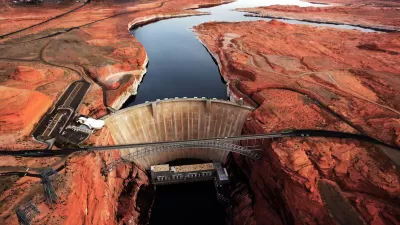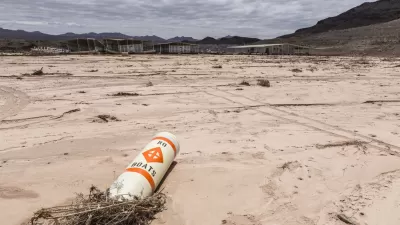Lake Powell levels could dip below the dam’s capacity to generate electricity, cutting off one of the Southwest’s most important power sources.

A piece by Jonathan Thompson highlights the crisis facing Lake Powell, which, as Planetizen has previously amplified, has reached its lowest level since Glen Canyon Dam was first constructed. “In March, Lake Powell’s surface level dropped to within 33 feet of the minimum needed to generate hydropower, for the first time since it was filled in the 1960s. If — or when — it hits that critical point, the Southwest power grid will lose one of its biggest electricity generators, as well as an indispensable backup power source.”
“Over the last few months, federal officials have attempted to stave off the power plant’s obsolescence by increasing releases from upstream dams and by sending less water downstream. But that failed to buoy reservoir levels, so now they have embarked on an effort to install turbines river outlet tubes lower on the dam, which would allow hydroelectricity generation to continue below minimum power pool — for a while.”
At full capacity, Glen Canyon Dam produces 1,300 megawatts of power. “In the 1990s, the dam produced as much as 7,000 gigawatt hours per year, enough to power nearly 600,000 homes. Last year, it was down to just 3,000 gigawatt hours.” Losing the power generated by the dam would increase costs, particularly for tribal nations. “The Navajo Tribal Utility Authority’s yearly power bill could jump by as much as $1.3 million, according to a 2016 consultant’s study, and nine other tribes would also see significant cost increases.”
FULL STORY: Powell’s looming power problem

Planetizen Federal Action Tracker
A weekly monitor of how Trump’s orders and actions are impacting planners and planning in America.

San Francisco's School District Spent $105M To Build Affordable Housing for Teachers — And That's Just the Beginning
SFUSD joins a growing list of school districts using their land holdings to address housing affordability challenges faced by their own employees.

The Tiny, Adorable $7,000 Car Turning Japan Onto EVs
The single seat Mibot charges from a regular plug as quickly as an iPad, and is about half the price of an average EV.

Seattle's Plan for Adopting Driverless Cars
Equity, safety, accessibility and affordability are front of mind as the city prepares for robotaxis and other autonomous vehicles.

As Trump Phases Out FEMA, Is It Time to Flee the Floodplains?
With less federal funding available for disaster relief efforts, the need to relocate at-risk communities is more urgent than ever.

With Protected Lanes, 460% More People Commute by Bike
For those needing more ammo, more data proving what we already knew is here.
Urban Design for Planners 1: Software Tools
This six-course series explores essential urban design concepts using open source software and equips planners with the tools they need to participate fully in the urban design process.
Planning for Universal Design
Learn the tools for implementing Universal Design in planning regulations.
Smith Gee Studio
City of Charlotte
City of Camden Redevelopment Agency
City of Astoria
Transportation Research & Education Center (TREC) at Portland State University
US High Speed Rail Association
City of Camden Redevelopment Agency
Municipality of Princeton (NJ)





























